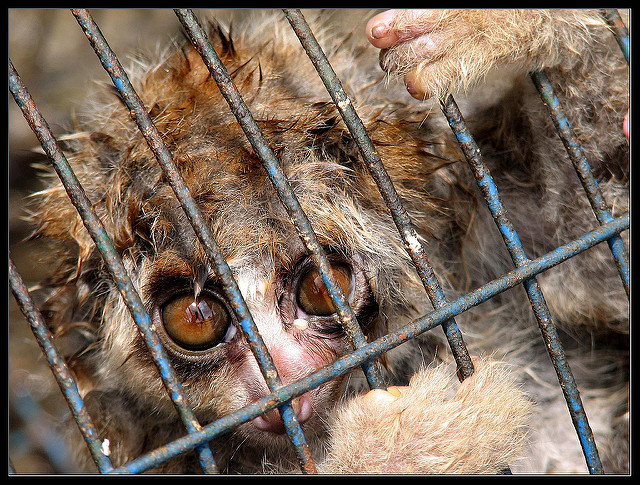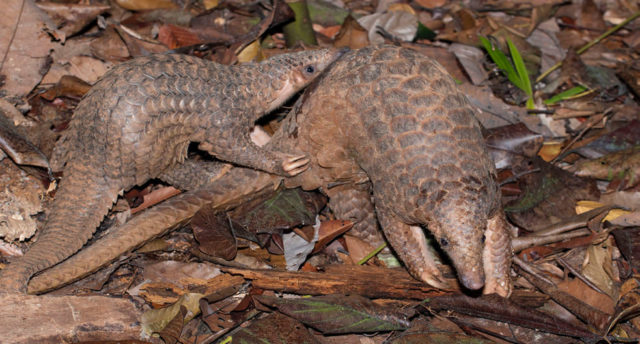Cyber-stalking wildlife traders
New online tools aim to save endangered animals, but experts say there are no easy shortcuts
Cici Zhang • June 12, 2017

A recent raid on an online trader in Indonesia rescued 19 endangered Javan slow lorises. [Image Credit: flickr user Michael Whitehead | CC BY-SA 2.0]
In a few small, cramped crates, 19 slow lorises were about to be shipped far from their rainforest home in West Java, Indonesia — if they didn’t die from stress along the way. The online buyers had confirmed the deal.
Fortunately, local officers tracked down the black-market trafficker and rescued the wide-eyed nocturnal primates. “We are sending a strong message to all online traders of wildlife that law enforcement does not tolerate such cases of illegal wildlife trade,” said Achmad Pribadi, an Indonesian forestry official, in a news story on the successful raid.
It was a rare victory in a conflict that seems to be getting worse all the time. A global report from the International Fund for Animal Welfare (IFAW) identified more than 30,000 live wild animals or animal parts for sale in 280 online marketplaces in 16 countries — and that was only during a six-week period of research in 2014.
“That’s just a tiny tiny snapshot of the true scale of online wildlife trade,” says Tania McCrea-Steele, who leads IFAW’s global wildlife cybercrime project. “Multiply that by all the countries of the world, over 190 countries, and you can imagine the trade is huge.” So huge, in fact, that it generates about $19 billion in revenue each year, according to the same report.
As governments struggle to curb the online wildlife trade through traditional police work, researchers, conservation groups and internet companies are looking for better, cheaper solutions. One of the leading ideas: automated search algorithms to identify traffickers and block sales before they can occur. Funded by government agencies and welcomed by conservation groups, the new algorithmic tools may eventually become an important weapon against wildlife cybercrime throughout the globe, but there are still many hurdles to clear, including language barriers, technical complexity and limited financial support.
One of the leading conservation organizations, the World Wildlife Fund, thinks the algorithms can eventually make a difference. “We’ve seen a clear shift from wildlife trafficking through physical storefronts to online marketplaces, including both e-commerce and social media,” says Giavanna Grein, a wildlife conservation program officer at the fund. “Automated search algorithms, once perfected, would certainly help to monitor and detect wildlife trafficking online,” Grein says.
Earlier this year, pangolins, the world’s most trafficked mammal, were featured on Google’s Valentine’s Day doodle. Thanks to the doodle, more people got to learn about these armored creatures who defend themselves by curling into a ball — some of which are critically endangered. Poachers killed over 1 million of them in the last decade.
More often, though, people use the internet to victimize pangolins, not to publicize their plight. A 2016 survey of 39 Chinese e-commerce websites found more than 150 ads for pangolin scales and meat in just 1 month.

The pangolin is an endangered species intensely hunted for their scales, meat and blood. [Image Credit: flickr user Smithsonian’s National Zoo | CC BY-NC-ND 2.0]
But many wildlife traffickers are still elusive on the internet. Part of the problem is that online sellers use code words to disguise their activity, says David Roberts, a conservation scientist who works on online wildlife tracking at the University of Kent in England. Ivory products, for example, can be coded as ox bone by sellers. In addition, the most obvious keywords might generate unwanted results. For instance, when searching for ivory, instead of elephant tusks you may find an ivory-colored wedding dress, says Roberts. “It’s like a needle in a haystack.”
Right now, Roberts says, policing for online wildlife trafficking in Great Britain is done by the National Wildlife Crime Unit and other enforcement teams. And it’s quite laborious: The officers have to manually search through pages of online items to find the illegal ones, says Roberts. “I do think they need more staff,” he says.
Roberts wants to help. In 2016, he and colleagues developed an algorithm to extract and analyze trade posts from the dark web, the part of the internet where buyers and sellers usually can operate anonymously thanks to encryption software. The researchers described the project in a paper published in the journal Conservation Biology. Using machine-learning techniques, they were able to search nearly 10,000 posts, but only found one that was potentially linked to illegal wildlife trade.
Why did Roberts’ search algorithm catch so few wildlife traders on the dark web? He thinks it’s because most traffickers are so unworried about getting caught that they’re comfortable operating on the open web without anonymity. He now plans to develop a similar tool for the open web that would allow much faster identification of illegal wildlife trading there, too.
A similar effort is underway in the United States, where another algorithmic tool is being developed by two researchers at New York University: environmental scientist Jennifer Jacquet and data scientist Sunandan Chakraborty. Their tool, the Enforcement Gaps Interface, was one of four grand prize winners in the Wildlife Crime Tech Challenge, a 2016 competition supported by the U.S. Agency for International Development.
The Enforcement Gaps Interface searches commercial sites for potential wildlife ads, saving enforcement agencies time from scouring through web pages all day and allowing them to better identify and reduce illegal trading activities. Besides mining text information like descriptions, prices and locations, the NYU researchers are also incorporating image recognition into their model to help identify which species are pictured in the ads.
Their next step, Jacquet says, is to develop a Chinese language version of the tool. Junchao Zheng, a master’s student who works with her, is feeding wildlife-related keywords and pictures from Chinese websites into a machine learning model he’s building. The scale of work is enormous: Zheng has trained the model with 3,000 pictures, but the goal is to automatically analyze one million ads simultaneously.
The NYU researchers are targeting China for good reason: According to IFAW’s report, Chinese websites host 56 percent of all wildlife products and live animals discovered in recent investigations.
In addition to building a Chinese-language version of their tool, the NYU team is also working to produce a version specific to California. “They have a different set of animals that interest them,” Jacquet says.
In preliminary tests, Jacquet’s tool achieved over 80 percent accuracy in identifying wildlife trafficking ads, and her team hopes soon to do more elaborate tests with enforcement agencies. “We’ve been in touch with wildlife enforcement. We show them early results, and they are interested,” she says.
IFAW’s McCrea-Steele thinks even more needs to be done. “I don’t think we’ve hit the jackpot just yet.” What’s needed, she says, are “more organizations that want to test out data-mining tools, until we find that tool that really does speed up the process.”
Internet companies are a critical player, as they run the platforms where illegal trading flourishes. Although not legally bound to do so, some companies have been actively combating the issue. EBay introduced an ivory ban in 2008. And on March 3, World Wildlife Day, the top three Internet companies in China — Baidu, Alibaba and Tencent — pledged to ban illegal wildlife products from their sites.
“What we are seeing is that especially some of the big online tech companies, they want to be part of the solution and not part of the problem,” says McCrea-Steele. IFAW has trained Tencent’s staff to identify and remove illegal wildlife posts from QQ and Wechat, two large social media platforms it owns.
But the very advantages of the internet — its globalism and accessibility — are what makes it so difficult to truly ban online wildlife trafficking. When one site implements a strict policy, for example, there’s often a whack-a-mole effect of increased activity on other sites. Hoping to minimize that effect, seven leading e-commerce and social media companies adopted a standardized wildlife policy in August 2016 in collaboration with several environmental groups. One of those groups, the World Wildlife Fund, is providing data to help the seven internet companies strengthen their internal algorithms, according to the fund’s conservation program officer Grein.
Funding is a crucial problem, too. The online aspect of wildlife crime doesn’t receive as much attention as the on-the-ground police work, says Roberts of the UK.
Great Britain’s National Wildlife Crime Unit has an annual budget of just £136,000 (about $170,000). Although it secures additional money for cyber enforcement, the amount is only about one-fifth of that small annual budget.
Roberts says he would like to keep working on his algorithms but lacks the funding he needs. His previous work was funded by a grant of just £20,000 (a little more than $25,000). Jacquet’s Enforcement Gaps Interface shares $900,000 with three other projects, awarded by the Wildlife Crime Tech Challenge.
Jacquet says that the money is well spent because better search algorithms will free up law enforcement officers from laborious web searches. “If you could automate [the search] it would obviously allow these people to work on some other aspects of wildlife trade,” says Jacquet. “There are so many other problems that need solving,” she says, like inspecting customs and warehouses or performing undercover operations.
Getting the public involved is also crucial to keeping wildlife traders out of online marketplaces, IFAW’s McCrea-Steele says. She wants citizens to lobby their governments for tougher enforcement, and to contact online sites directly if they see any wildlife products that might be traded illegally.
“We need everybody to be our eyes and ears tackling wildlife cybercrime,” McCrea-Steele says. “I want to make sure that those animals are there for future generations to enjoy.”
2 Comments
Is there any way to ask for public crowdfunding?? This would be such an effective tool it’s worthy of public involvement and investment
Can I suggest you change the title of this article to use “cyber-sleuthing” instead of “cyberstalking”? Cyberstalking is a crimen, generally a felony and always has some element of physical or extreme emotional injury. “Cybersleuthing” on the other hand, is an appropriate, emerging set of tools for discovering truth under layers of obfuscation and deceit.